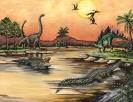The Arctic tundra is a vast area of stark landscape and is frozen for much of the year. The soil there is frozen from 25–90 cm down, and it is impossible for trees to grow. Instead, bare and sometimes rocky land can only support low growing plants such as moss, heath (Ericaceae varieties such as crowberry and black bearberry), and lichen. There are two main seasons, winter and summer, in the polar tundra areas. During the winter it is very cold and dark, with the average temperature around −28 °C (−18.4 °F), sometimes dipping as low as −50 °C (−58.0 °F).
The tundra is a very windy area, with winds often blowing upwards of 48–97 km/h However, in terms of precipitation, it is desert-like, with only about 15–25 cm falling per year. During the summer, the permafrost thaws just enough to let plants grow and reproduce, but because the ground below this is frozen, the water cannot sink any lower, and so the water forms the lakes and marshes found during the summer months.
A forest is an area with a high density of trees. There are many definitions of a forest, based on the various criteria.[1] These plant communities cover approximately 9.4% of the Earth's surface (or 30% of total land area), though they once covered much more in many different regions and function as habitats for organisms, hydrologic flow modulators, and soil conservers, constituting one of the most important aspects of the Earth's biosphere.
Forests sometimes contain many tree species within a small area (as in tropical rain and temperate deciduous forests), or relatively few species over large areas. Forests are often home to many animal and plant species, and biomass per unit area is high compared to other vegetation communities.
Saturday, February 20, 2010
Subscribe to:
Post Comments (Atom)

I think it is interesting and gives a lot of information.
ReplyDeletebrandon